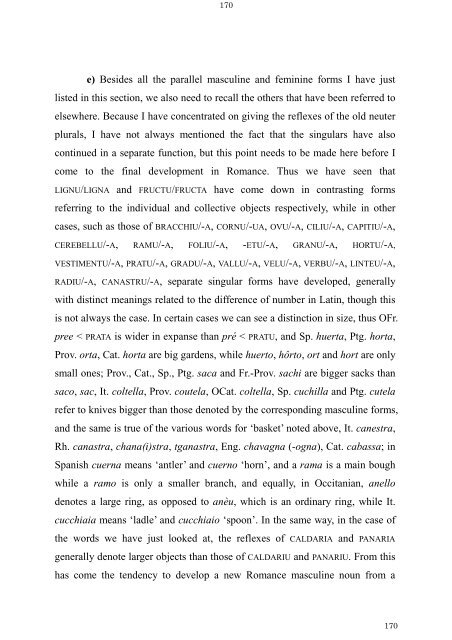The Latin Neuter Plurals in Romance - Page ON
The Latin Neuter Plurals in Romance - Page ON
The Latin Neuter Plurals in Romance - Page ON
You also want an ePaper? Increase the reach of your titles
YUMPU automatically turns print PDFs into web optimized ePapers that Google loves.
170<br />
e) Besides all the parallel mascul<strong>in</strong>e and fem<strong>in</strong><strong>in</strong>e forms I have just<br />
listed <strong>in</strong> this section, we also need to recall the others that have been referred to<br />
elsewhere. Because I have concentrated on giv<strong>in</strong>g the reflexes of the old neuter<br />
plurals, I have not always mentioned the fact that the s<strong>in</strong>gulars have also<br />
cont<strong>in</strong>ued <strong>in</strong> a separate function, but this po<strong>in</strong>t needs to be made here before I<br />
come to the f<strong>in</strong>al development <strong>in</strong> <strong>Romance</strong>. Thus we have seen that<br />
LIGNU/LIGNA and FRUCTU/FRUCTA have come down <strong>in</strong> contrast<strong>in</strong>g forms<br />
referr<strong>in</strong>g to the <strong>in</strong>dividual and collective objects respectively, while <strong>in</strong> other<br />
cases, such as those of BRACCHIU/-A, CORNU/-UA, OVU/-A, CILIU/-A, CAPITIU/-A,<br />
CEREBELLU/-A, RAMU/-A, FOLIU/-A, -ETU/-A, GRANU/-A, HORTU/-A,<br />
VESTIMENTU/-A, PRATU/-A, GRADU/-A, VALLU/-A, VELU/-A, VERBU/-A, LINTEU/-A,<br />
RADIU/-A, CANASTRU/-A, separate s<strong>in</strong>gular forms have developed, generally<br />
with dist<strong>in</strong>ct mean<strong>in</strong>gs related to the difference of number <strong>in</strong> <strong>Lat<strong>in</strong></strong>, though this<br />
is not always the case. In certa<strong>in</strong> cases we can see a dist<strong>in</strong>ction <strong>in</strong> size, thus OFr.<br />
pree < PRATA is wider <strong>in</strong> expanse than pré < PRATU, and Sp. huerta, Ptg. horta,<br />
Prov. orta, Cat. horta are big gardens, while huerto, hôrto, ort and hort are only<br />
small ones; Prov., Cat., Sp., Ptg. saca and Fr.-Prov. sachi are bigger sacks than<br />
saco, sac, It. coltella, Prov. coutela, OCat. coltella, Sp. cuchilla and Ptg. cutela<br />
refer to knives bigger than those denoted by the correspond<strong>in</strong>g mascul<strong>in</strong>e forms,<br />
and the same is true of the various words for ‘basket’ noted above, It. canestra,<br />
Rh. canastra, chana(i)stra, tganastra, Eng. chavagna (-ogna), Cat. cabassa; <strong>in</strong><br />
Spanish cuerna means ‘antler’ and cuerno ‘horn’, and a rama is a ma<strong>in</strong> bough<br />
while a ramo is only a smaller branch, and equally, <strong>in</strong> Occitanian, anello<br />
denotes a large r<strong>in</strong>g, as opposed to anèu, which is an ord<strong>in</strong>ary r<strong>in</strong>g, while It.<br />
cucchiaia means ‘ladle’ and cucchiaio ‘spoon’. In the same way, <strong>in</strong> the case of<br />
the words we have just looked at, the reflexes of CALDARIA and PANARIA<br />
generally denote larger objects than those of CALDARIU and PANARIU. From this<br />
has come the tendency to develop a new <strong>Romance</strong> mascul<strong>in</strong>e noun from a<br />
170









